Abstract
Maximum likelihood detection for MIMO systems can be formulated as an integer quadratic programming problem. In this paper, we introduce depth-first branch and bound algorithm with variable dichotomy into MIMO detection. More nodes may be pruned with this structure. At each stage of the branch and bound algorithm, active set algorithm is adopted to solve the dual subproblem. In order to reduce the complexity further, the Cholesky factorization update is presented to solve the linear system at each iteration of active set algorithm efficiently. By relaxing the pruning conditions, we also present the quasi branch and bound algorithm which implements a good tradeoff between performance and complexity. Numerical results show that the complexity of MIMO detection based on branch and bound algorithm is very low, especially in low SNR and large constellations.
Similar content being viewed by others
References
Tan P H, Rasmussen L K, Lim T J. Constrained maximum-likelihood detection in CDMA. IEEE Trans Commu, 2001, 49(1): 142–153
Viterbo E, Boutros J. A universal lattice code decoder for fading channels. IEEE Trans Info Theory, 1999, 45(5): 1639–1642
Jalden J, Ottersten B. On the complexity of sphere decoding in digital communications. IEEE Trans Signal Proc, 2005, 53(4): 1474–1484
Luo J, Pattipati K, Willett P, et al. Branch-and-bound-based fast optimal algorithm for multiuser detection in synchronous CDMA. In: Proc IEEE Inter Confer Commu, US, Alaska: Anchorage, 2003. 3336–3340
Murugan A D, Gamal H E, Damen M O, et al. A unified framework for tree search decoding: rediscovering the sequential decoder. IEEE Trans Info Theory, 2006, 52(3): 933–953
Stojnic M, Vikalo H, Hassibi B. A branch and bound approach to speed up the sphere decoder. In: Proc IEEE Inter Confer Acoustics, Speech, and Signal Processing, Philadelphia, PA, 2005: 429–432
Steingrimsson B, Luo T, Wong K M. Soft quasi-maximum-likelihood detection for multiple-antenna wireless channels. IEEE Trans Sig Proc, 2003, 51(11): 2710–2719
Wiesel A, Eldar Y C, Shamai S. Semidefinite relaxation for detection of 16-QAM signaling in mimo channels. IEEE Sig Proc Lett, 2005, 12(9): 653–656
Nemhauser G L, Wolsey L A. Integer and Combinatorial Optimization. New York: Wiley, 1988
Golub G H, Van Loan C F. Matrix computations. Baltimore MD: John Hopkins University Press, 1996
Garey M R, Johnson D S. Computers and Intractability, A guide to the Theory of NP Completeness, New York: W. H. Freeman and Company, 1979
Land A H, Doig A G. An automatic method for solving discrete programming problems. Econo, 1960, 28(3): 497–520
Mitten L G. Branch-and-bound methods: general formulation and properties. Oper Res, 1970, 18: 24–34
Gill P E, Murray W, Wright M H. Practical Optimization. New York: Academic Press, 1981
Coleman T, Li Y. A reflective Newton method for minimizing a quadratic function subject to bounds on some of the variables. SIAM J Optim, 1996, 6(4): 1040–1058
Li W, Nijs J de. An implementation of QSPLINE method for solving convex quadratic programming problems with simple bound constraints. J Math Sci, 2003, 116(4): 3387–3410
Dai Y H, Fletcher R. Projected Barzilai-Borwein methods for large-scale box-constrained quadratic programming. University of Dundee Report NA/215, 2003
Vikalo V, Hassibi B. On the sphere-decoding algorithm II. generalizations, second-order statistics, and applications to communications. IEEE Trans Sig Proc, 2005, 53(8): 2819–2834
Author information
Authors and Affiliations
Corresponding authors
Additional information
Supported by Jiangsu Natural Science Fund Project (Grant No. BK2006002), and the Open Research Foundation of National Mobile Communications Research Laboratory, Southeast University (Grant No. N200601)
Rights and permissions
About this article
Cite this article
Li, Z., Cai, Y. Maximum-likelihood detection based on branch and bound algorithm for MIMO systems. Sci. China Ser. F-Inf. Sci. 51, 306–319 (2008). https://doi.org/10.1007/s11432-008-0022-4
Received:
Accepted:
Issue Date:
DOI: https://doi.org/10.1007/s11432-008-0022-4




